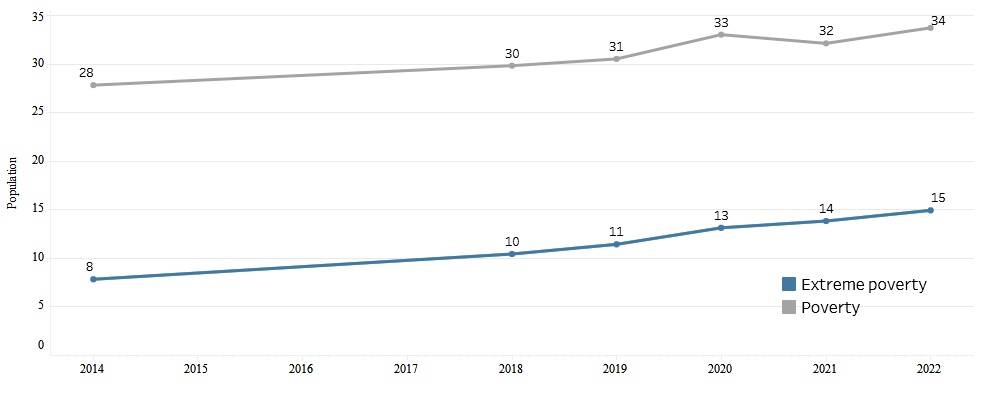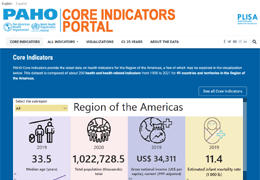
The economic situation of the Region of the Americas has been impacted by the contraction of economic growth in most countries of the Region, high rates of inflation, and increased unemployment, poverty, and food insecurity rates (). The factors with the most significant influence on these trends are high commodity prices and disruptions in international supply chains, resulting in increased costs.
Economic growth
The pandemic and the measures to contain and mitigate it have contributed to the biggest global economic recession since the mid-20th century, with declines in gross domestic product (GDP) in the Region exceeding those in other regions of the world (). Globally, the Latin America and the Caribbean subregion was the most affected in socioeconomic terms (), registering a 6.9% decline in GDP in 2020 (). During 2021, the Region's GDP grew 6.5% as a result of global economic recovery, along with progress in COVID-19 vaccination. A 2.7% decline is predicted for 2022 (Figure 1) ().
While the effects of the conflict between the Russian Federation and Ukraine are not yet fully understood (), the war is expected to amplify the trends already observed as a result of the pandemic (). At the subregional level, it is estimated that the economy of South America will grow by 2.6%, Central America and Mexico by 2.5%, and the Caribbean, not including Guyana, by 4.7% ().
Figure 1. Economic growth in the Region of the Americas, 2021-2023, by subregion (%)

Note: a Data not available for all years.
Sources: 1 International Monetary Fund. World economic outlook Update July 2022: Gloomy and more uncertain. Washington, DC: IMF; 2022. Available from: https://www.imf.org/es/Publications/WEO/Issues/2022/07/26/world-economic-outlook-update-july-2022.
2 International Monetary Fund. World economic outlook: Managing divergent recoveries. Washington, DC: IMF; 2021. Available from: https://www.imf.org/es/Publications/WEO/Issues/2021/03/23/world-economic-outlook-april-2021.
3 Economic Commission for Latin America and the Caribbean. Economic Survey of Latin America and the Caribbean, 2022: Trends and challenges of investing for a sustainable and inclusive recovery (LC/PUB.2022/9-P). Santiago: ECLAC; 2022. Available from: https://hdl.handle.net/11362/48078.
4 Economic Commission for Latin America and the Caribbean. CEPALSTAT. Main Figures of Latin America and the Caribbean. Santiago: ECLAC; 2022. Available from: https://statistics.cepal.org/portal/cepalstat/index.html?lang=en.
Inflation
In the second half of 2021, the Latin America and the Caribbean subregion reached inflation rates of 6.6%, an unprecedented level since October 2008 (), except in the cases of Argentina, the Plurinational State of Bolivia, Haiti, Suriname, and the Bolivarian Republic of Venezuela, all of which already had high inflation prior to the pandemic. By April 2022, inflation stood at 8.1%, and at the time this report is written, it is expected to remain high for the rest of the year (). As more developed countries continue to raise interest rates and global economic conditions become more complex, vulnerabilities and financial risks will increase (), especially for the economies of Latin America and the Caribbean (,).
As long as the effects of the conflict between the Russian Federation and Ukraine continue to be felt, food and energy prices may continue to rise. High inflation will contribute to greater financial uncertainty and will make investments in social and health programs less of a priority, since it can be assumed that countries' top priority will be to contain inflation (). At the same time, measures to contain inflation through monetary and fiscal policy could cause social discontent. Accordingly, such measures should include additional support to protect vulnerable populations.
Unemployment
As one of the collateral effects of the pandemic, unemployment rates reached an average of 11.5% in Latin America and the Caribbean in 2020. This rate had fallen to 8.0% by the end of 2021, thanks to the economic recovery (); however, the unemployment rate in the subregion did not fall to 2019 levels (7.8%) (). Unfortunately, ECLAC forecasts that job creation will decline during 2022 due to lower economic growth. According to ECLAC, the combination of higher labor participation and slow job creation could contribute to higher unemployment rates.
Poverty
Before the pandemic, the Region of the Americas faced setbacks in poverty, extreme poverty, and income distribution. The pandemic exacerbated existing inequities in the Region, widening the gap. In Latin America and the Caribbean, poverty had been showing an upward trend, rising from 27.8% in 2014 to 33.7% in 2022 (Figure 2), representing 22 million more people living below the poverty line, of whom 8 million (36%) are in extreme poverty. The COVID-19 pandemic contributed to this trend becoming more pronounced in 2020.
During 2021, thanks to economic recovery in the Region, a reduction in the poverty rate was observed as COVID-19 vaccination coverage increased. However, with increased inflation, the poverty rate is expected to rise in 2022. Additionally, extreme poverty in Latin America and the Caribbean has maintained its upward trend since 2014 (7.8%) (), doubling in just eight years (14.9%), despite the fiscal initiatives deployed in the subregion. In this context, if the cost of food continues to rise, the impact will be noticeable not only among people living in poverty, but also among middle-income families. Regarding social inequality, the variation rate of the Gini coefficient increased by an average of 0.7% in the same year ().
Figure 2. Trend in poverty and extreme poverty rates in Latin America and the Caribbean, 2014–2022 (%)

Source: Economic Commission for Latin America and the Caribbean. Repercussions in Latin America and the Caribbean of the war in Ukraine: how should the region face this new crisis? Santiago: ECLAC; 2022. Available from: https://repositorio.cepal.org/handle/11362/47913.
During the pandemic, school closures disrupted school food programs. This increased food insecurity, which can cause long-term harm to health, productivity, development, behavioral functioning, and learning in the child and adolescent population in the Region. Schools play a role that goes beyond teaching. They protect the rights of minors and help them improve their social and emotional state, which was affected by confinement at home.
Food insecurity
Even before the pandemic, undernutrition prevalence rates in the Region of the Americas were increasing, from 5.4% in 2014 to 7.1% in 2019, and 9.1% in 2020, a level not seen since 2005 (). The Caribbean is the subregion that has been the most affected, with undernutrition affecting 16.1% of the population in 2020. It is estimated that in 2020 there were 14 million more people living with hunger than in 2019 (). This figure is in addition to the 86.4 million who were already living with food insecurity. One of the factors contributing to the increase in hunger was the rapid rise in food prices that began in early 2020 (), exceeding inflation (Table 1). Inflation in food prices is a major contributor to the increase in poverty. It is estimated that inflation for the most disadvantaged socioeconomic strata is between 10% and 40% higher than for other socioeconomic strata.
Table 1. Annual food and beverage inflation rates and total inflation, selected Latin American countries, 2021–2022
| Food and beverage inflation | Total inflation | |||||
|---|---|---|---|---|---|---|
| Country | 2021 average | February 2022 | March 2022 | 2021 average | February 2022 | March 2022 |
| Brazil | 12,4 | 9,1 | 11,6 | 8,2 | 10,5 | 11,3 |
| Chile | 4,7 | 8,2 | 12,0 | 4,5 | 7,8 | 9,4 |
| Colombia | 9,0 | 21,6 | 23,5 | 3,5 | 8,0 | 8,5 |
| Costa Rica | 2,4 | 7,3 | 9,5 | 1,7 | 4,9 | 5,8 |
| Ecuador | –0,8 | 2,7 | 2,2 | 0,1 | 2,7 | 2,6 |
| El Salvador | 2,3 | 9,5 | 9,8 | 3,5 | 6,7 | 6,7 |
| Guatemala | 4,9 | 3,2 | 4,9 | 4,3 | 3,0 | 4,2 |
| Mexico | 6,8 | 11,7 | 12,1 | 5,7 | 7,3 | 7,5 |
| Paraguay | 8,2 | 14,5 | 16,2 | 4,8 | 9,3 | 10,1 |
| Peru | 4,7 | 7,9 | 9,1 | 4,0 | 6,1 | 6,8 |
| Uruguay | 7,8 | 9,7 | 11,2 | 7,8 | 8,8 | 9,4 |
Source: Economic Commission for Latin America and the Caribbean. Repercussions in Latin America and the Caribbean of the war in Ukraine: how should the region face this new crisis? Santiago: ECLAC; 2022. Available from: https://repositorio.cepal.org/handle/11362/47913.


